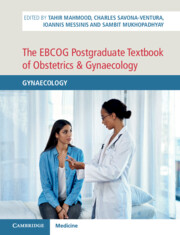Book contents
- The EBCOG Postgraduate Textbook of Obstetrics & Gynaecology
- The EBCOG Postgraduate Textbook of Obstetrics & Gynaecology
- Copyright page
- Dedication
- Contents
- Videos
- Contributors
- Preface
- Section 1 Basic Sciences in Gynaecology
- Section 2 Menstrual Disorders
- Section 3 Reproductive Endocrinology and Infertility
- Section 4 Contraception and STIs
- Section 5 Post-Reproductive Care
- Section 6 Vulva and Vagina
- Section 7 Cervix
- Section 8 Uterus
- Section 9 Ovary and Fallopian Tubes
- Section 10 Operative Gynaecology
- Section 11 Public Health Issues in Gynaecology
- Chapter 51 Clinical Governance in Gynaecology
- Chapter 52 Prevention of Unintended Pregnancy
- Chapter 53 HPV Immunization
- Chapter 54 Screening for Gynaecological Cancers
- Chapter 55 Female Genital Mutilation/Cutting
- Chapter 56 Genetics and Gynaecological Disease
- Chapter 57 Legal and Ethical Issues in Gynaecological Practice
- Section 12 Miscellaneous
- Index
- Plate Section (PDF Only)
- References
Chapter 52 - Prevention of Unintended Pregnancy
from Section 11 - Public Health Issues in Gynaecology
Published online by Cambridge University Press: 24 November 2021
- The EBCOG Postgraduate Textbook of Obstetrics & Gynaecology
- The EBCOG Postgraduate Textbook of Obstetrics & Gynaecology
- Copyright page
- Dedication
- Contents
- Videos
- Contributors
- Preface
- Section 1 Basic Sciences in Gynaecology
- Section 2 Menstrual Disorders
- Section 3 Reproductive Endocrinology and Infertility
- Section 4 Contraception and STIs
- Section 5 Post-Reproductive Care
- Section 6 Vulva and Vagina
- Section 7 Cervix
- Section 8 Uterus
- Section 9 Ovary and Fallopian Tubes
- Section 10 Operative Gynaecology
- Section 11 Public Health Issues in Gynaecology
- Chapter 51 Clinical Governance in Gynaecology
- Chapter 52 Prevention of Unintended Pregnancy
- Chapter 53 HPV Immunization
- Chapter 54 Screening for Gynaecological Cancers
- Chapter 55 Female Genital Mutilation/Cutting
- Chapter 56 Genetics and Gynaecological Disease
- Chapter 57 Legal and Ethical Issues in Gynaecological Practice
- Section 12 Miscellaneous
- Index
- Plate Section (PDF Only)
- References
Summary
There is evidence that a significant proportion of pregnancies are unintended at conception. Pregnancy planning allows for optimization of a woman’s health prior to conception and is associated with improved outcomes for both mother and baby. Certain periods during the female life course are associated with an increased risk of unintended pregnancy, such as adolescence, or where the risk of pregnancy is under-recognized, such as post-pregnancy and the perimenopause. Interactions with obstetricians and gynaecologists may provide opportunities for prevention through education and enhanced contraceptive provision.
- Type
- Chapter
- Information
- The EBCOG Postgraduate Textbook of Obstetrics & GynaecologyGynaecology, pp. 449 - 456Publisher: Cambridge University PressPrint publication year: 2021

